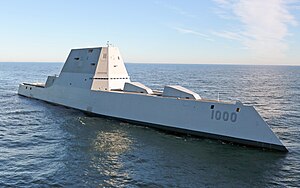Zumwalt class destroyer

USS Zumwalt undergoing sea trials.
|
|
| Class overview | |
|---|---|
| Builders: | Bath Iron Works |
| Operators: |
|
| Preceded by: | Arleigh Burke class |
| Cost: |
|
| In commission: | 15 October 2016 |
| Building: | 1 |
| Planned: | 32 |
| Completed: | 2 |
| Cancelled: | 29 |
| General characteristics | |
| Type: | guided missile destroyer |
| Displacement: | 14,564 long tons (14,798 t) |
| Length: | 600 ft (180 m) |
| Beam: | 80.7 ft (24.6 m) |
| Draft: | 27.6 ft (8.4 m) |
| Propulsion: |
|
| Speed: | In excess of 30 kn (56 km/h; 35 mph) |
| Troops: | U.S. Marines |
| Complement: | 140 |
| Sensors and processing systems: |
AN/SPY-3 Multi-Function Radar (MFR) (X band active electronically scanned array) |
| Armament: |
|
| Aircraft carried: |
|
| Aviation facilities: | Flight deck and enclosed hangar for up to two medium-lift helicopters |
The Zumwalt-class destroyer is a class of United States Navy guided missile destroyers designed as multi-mission stealth ships with a focus on land attack. The class emerged from the previous DD-21 vessel program, previously known as the "DD(X)". The class is multi-role and designed for surface warfare, anti-aircraft warfare, and naval gunfire support. They take the place of battleships in filling the former congressional mandate for naval fire support, though the requirement was reduced to allow them to fill this role. The vessels' appearance has been compared to that of the historic ironclad warship.
The class has a low radar cross-section; an integrated power system that can send electricity to the electric drive motors or weapons, the Total Ship Computing Environment Infrastructure (TSCEI), automated fire-fighting systems, automated piping rupture isolation, and may someday include a railgun or free-electron lasers. The class is designed to require a smaller crew and be less expensive to operate than comparable warships. It has a wave-piercing tumblehome hull form whose sides slope inward above the waterline, which has been stated to reduce the radar cross-section (RCS) by returning much less energy than a conventional flare hull form. The U.S. Naval Institute stated "the original design of the ship would have had a much smaller RCS, but cost considerations prompted the Navy over the last several years to make the trades in increasing RCS to save money..."
The lead ship is named Zumwalt for Admiral Elmo Zumwalt, and carries the hull number DDG-1000. Originally 32 ships were planned, with $9.6 billion research and development costs spread across the class. As costs overran estimates, the quantity was reduced to 24, then to 7, and finally to 3, significantly increasing the cost-per-ship to $3.96 billion (excluding R&D costs) – well-exceeding the per-unit cost of a nuclear-powered Virginia-class submarine ($2.688 billion). The dramatic per-unit cost increases eventually triggered a Nunn-McCurdy Amendment breach and cancellation of further production. In April 2016, the total program cost was $22.5 billion with an average cost of $7.5 billion per ship.
...
Wikipedia
